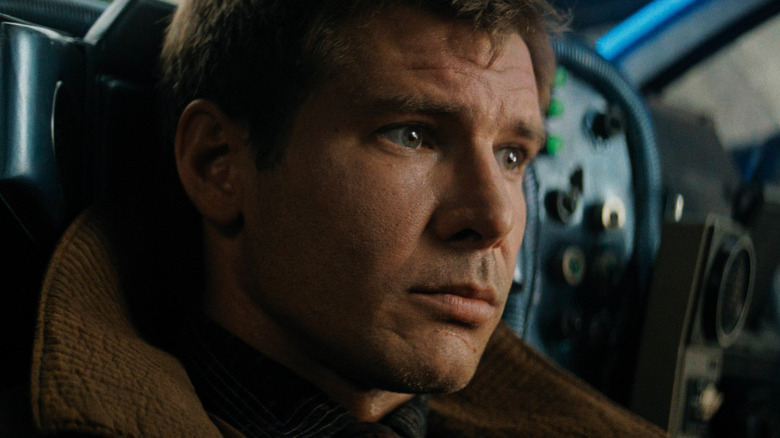How Blade Runner's Production Was Almost Shut Down During Its Final Days
Rightly regarded now as a classic, the original "Blade Runner" faced many significant hurdles on its road to movie greatness. Ridley Scott's 1982 film utilized some of the neon from the set of Francis Ford Coppola's Las Vegas-set musical romance, "One from the Heart," the same box-office bomb that — together with Michael Cimino's "Heaven's Gate" — traditionally demarcates the end of the New Hollywood era. "Blade Runner" came at the tail end of that fertile period when filmmakers like Scott, Coppola, and William Friedkin thrived within the studio system, enjoying unprecedented creative control and merging their own artistic inclinations with the general public's taste.
In a 2017 Vanity Fair retrospective, Scott himself likened his approach on "Blade Runner" to that of a "benevolent dictatorship." That was part of the problem, which almost sank the movie before anyone ever saw it.
Years later, "Blade Runner 2049" production designer Michael Gassner, who worked in the art department on "One from the Heart," recalled how Scott was able to salvage neon signs from Coppola's flop, lifting his own new futuristic vision from the Vegas ashes. Yet in its own way, "Blade Runner" was almost just as much of a disaster.
The movie hit theaters the same weekend as John Carpenter's "The Thing," another film that was initially a commercial and critical disappointment, only to be reevaluated later as an exemplar of sci-fi horror, not unlike Scott's own "Alien." Both flicks were competing with Steven Spielberg's "E.T. the Extraterrestrial," which had just begun its domination two weeks earlier. Fortunes were drying up for dark-minded New Hollywood auteurs, and moviegoers were gravitating more toward lighter, more family-friendly entertainment.
However, before its release, there were other factors going on behind the scenes that threatened to derail the production of "Blade Runner" altogether.
Forged by Creative Conflict
"Blade Runner" is credited to two screenwriters, Hampton Fancher and David Peoples, the former of whom also conceived and co-wrote "Blade Runner 2049," and the latter of whom would go on to write and co-write "Unforgiven" and "12 Monkeys." Peoples was only brought in later—to rewrite Fancher's script behind his back. According to Vanity Fair, Fancher's draft was "set mostly indoors," and Scott wanted to open the world out, so we could see those images of flying cars and geisha billboards in a neo-noir L.A., based on concepts by "visual futurist" Syd Mead.
Peoples was able to write faster than Fancher and obey Scott's marching orders better. Not everyone in the crew took kindly to Scott's directorial style, however. When an article quoted him saying he preferred British to American crews, since "he could tell them what he wanted and they'd reply, 'Yes, Guv'nor,' " his "Blade Runner" crew responded by wearing custom T-shirts emblazoned with, "YES GUV'NOR MY ASS!"
Toward the end, they were slogging through 36-hour days, even as a director's strike and budgetary issues loomed over the production and came close to shutting it down. Sean Young had her own issues with Scott; in an interview with The Daily Beast, she later suggested these spilled over into Scott's direction of the rough love scene between her character, Rachel, and Harrison Ford's protagonist, Rick Deckard.
To top it all off, Scott and Ford weren't getting along, either. It's a well-known bit of movie lore that they had fundamental disagreements over the question of whether Deckard was a replicant or human.
Hearing stories like these, it's a miracle that "Blade Runner" even got made. It just goes to show that sometimes the best movies are forged by creative conflict.

